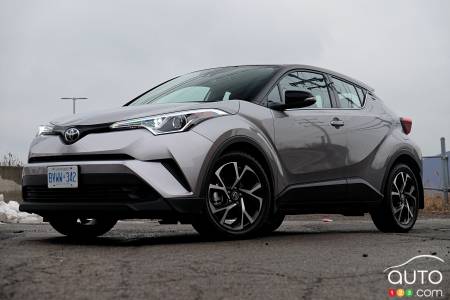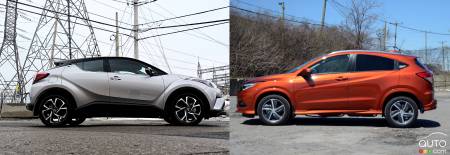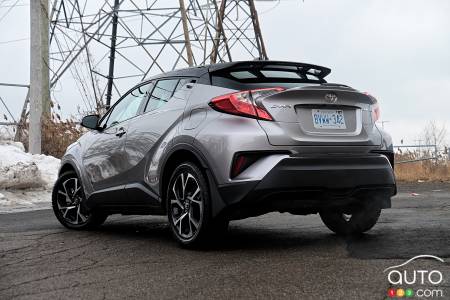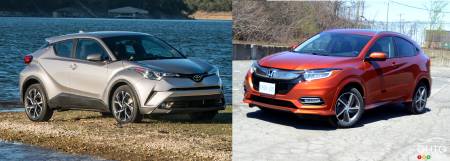The small urban utility segment might still be relatively young, it’s quickly made room for itself. While the Honda HR-V arrived in 2016 and the Toyota C-HR in 2018, both models offer undeniable qualities. The question is, which offers the most for the money for consumers in Canada?
2019 Honda HR-V
It actually Honda took a while to take the leap into the world of small urban utilities. Seeing that even North Americans were growing enthusiastic for this kind of vehicle, Honda took a Fit platform, dressed it up differently and added an optional all-wheel drive, and voilà, the HR-V was born.
Small touch-ups
For 2019, cosmetic changes take the form of new bumpers, headlights and taillights, and a new grille, while the interior gets Honda's latest infotainment system, including Apple CarPlay and Android Auto, the return of a volume-control knob for the audio system and a new instrument cluster.
.jpg?scaledown=450)
Versatile interior
In the cabin, Honda still offers the magic seat originally borrowed from the Honda Fit. It allows you to raise the seat back of the rear seats and, thanks to the flat floor, slide in high and bulky objects. The trunk, good for 688 litres (657 in 4WD version, is the largest in the category.
True to its reputation, the interior is sober in nature with a quality of construction you’d be hard-pressed to find fault with. The new safety package includes automatic emergency braking, adaptive cruise control and lane maintenance assistance, which come on top of the forward collision and lane departure warning systems first included in last year's model. Honda also promises it has improved the quality of the soundproofing.
Small 4-cylinder
As before, all HR-Vs use a 1.8L 4-cylinder engine producing 141 hp and 127 lb-ft of torque. This engine is exclusively associated with a continuously variable automatic transmission (CVT). The all-wheel drive is standard in Sport and Touring and optional in the LX.
.jpg?scaledown=450)
Plain but efficient
It’s important to understand that when driving the HR-V you’re not at the wheel of a sports car. Performance is modest, but the handling is decent thanks to a stiff chassis and excellent driving balance. Space for all passengers, including those in the back, is very good and, very importantly, Honda has finally achieved better soundproofing. In contrast with the rather noisy Fit, the HR-V is much quieter. Discreet, efficient and reliable - a product in the image of Honda.
Consult our listing of pre-owned Honda HR-V vehicles available in your region of Canada
2019 Toyota C-HR
The C-HR (for Coupe High-Rider) was originally designed for the Scion division, but it had the bad timing to appear on the market just as Toyota was closing its youth-oriented division. Not to be denied, the feisty CH-R found its way to Toyota. This history explains the model’s offbeat styling that looks a bit out of place not just in the Toyota lineup, but also in this segment.

Some modifications for 2019
Changes include a new LE trim level that reduces the base price by more than $1,000 from last year. There are also some new standard features, including a windshield defroster, Toyota's Entune 3.0 infotainment system (which now supports the Android Auto integration platform in addition to Apple CarPlay) and an 8-inch touchscreen to access it all.
The XLE version returning from last year now gets Entune Audio 3.0 Plus, and the new Limited version features leather seats, ambient interior lighting and rain-sensing windshield wipers.
Modest performance
While the styling is certainly unusual and playful, the same can’t be said about the C-HR’s performance. Under the hood sits a 2.0L 4-cylinder engine making 144 hp and 139 lb-ft of torque, sent to the front wheels. These figures are very similar to those of the HR-V but, there is a big difference in that the C-HR comes only in two-wheel drive version, no all-wheel drive - a drawback for Canadians who have to deal with winter driving conditions.
The generous interior constitutes a pleasant surprise, as it provides decent space for four adults despite a narrow roofline the design of which warns from the outside of a narrow cabin.
The base model is equipped with 17-inch steel wheels, but it includes power windows, dual-zone climate control, auto-dimming rearview mirror, keyless entry system, heated exterior mirrors and rear-window wiper. The XLE adds alloy wheels (also 17-inch) and heated front seats, Entune Audio 3.0 Plus, a leather-wrapped steering wheel and lumbar support for the electric driver's seat. You have to go for the Limited version to enjoy leather seats.
The drive
The two models have comparable behavior on the road because, for one, engine displacement and power are nose-to-nose and, for two, both use a CVT transmission. This means that you have to stay calm, not push these machines abruptly and then you can have an enjoyable drive. If the comfort of the seats in both models is comparable, the sightlines are better in the HR-V because of the slightly bizarre lines of the C-HR impair visibility.
Consult our listing of pre-owned Toyota vehicles available in your region of Canada

Advantage Honda HR-V
The HR-V offers an all-wheel drive system that is missing from the C-HR. There’s more space for luggage in the back, a better interior finish and superior handling. It should also be mentioned that the base price is slightly lower and the fuel consumption better.
Advantage Toyota C-HR
With the standard Safety Sense suite, Toyota has a slight safety edge. Same thing on the technology front with a standard 8-inch screen that accesses the Entune system and a few more technologies than Honda’s mini-ute musters.
Similarities
We now find Apple CarPlay and Android Auto in both vehicles. The two models offer similar power with CVT transmissions. The level of reliability is not an issue in either case, and the warranty coverage is also similar.
Verdict
Despite the undeniable qualities of the Toyota C-HR, the Honda HR-V comes out ahead in too many categories. It's bigger, more convenient and better laid-out, offers 4WD and comes at a lower starting price, on top of being more economical at the pump. This is in our opinion one of the best vehicles in the segment.

2019 Honda HR-V
We like
Generous space
Proven reliability
Practical layout
We like less
Engine noise due to the CVT
Dull to drive
Annoying touchscreen
2019 Toyota C-HR
We like
Unique styling
Solid chassis
Fun to drive
We like less
No AWD
Rear visibility
Awkward interior
.jpg?scaledown=450)

Specifications
| ... | 2019 Honda HR-V | 2019 Toyota C-HR | |
| Transmission | CVT | CVT | |
| Rouage | 2 or AWD | FWD | |
| Fuel consumption (city) | 8.3 L/100 km | 8.7 L/100 km | |
| Fuel consumption (highway) | 6.9 L/100 km | 7.5 L/100 km | |
| AWD | |||
| Fuel consumption (city) | 9.4 L/100 km | ||
| Fuel consumption (highway) | 7.1 L/100 km | ||
| Engine | |||
| Type | Gas | Gas | |
| Output | 141 hp | 144 hp | |
| Torque | 127 lb-ft | 139 lb-ft | |
| Cylinders | 4 | 4 | |
| Displacement | 1.8L | 2.0L | |
| Capacities | |||
| Cargo Space | 688 L, 1,665 L | 538 L, 1,031 L | |
| Fuel Tank | 50 L | 53 L | |
| Dimensions | |||
| Length | 4294 mm | 4350 mm | |
| Width | 1772 mm | 1797 mm | |
| Height | 1605 mm | 1565 mm | |
| Wheelbase | 2610 mm | 2640 mm | |
| Warranty | 3 yrs/60,000 km | 3 yrs/60,000 km | |
| Price | $23,300 to $32,000 | $23,675 to $28,775 | |




